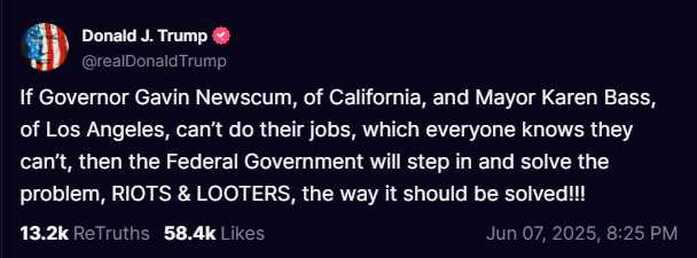When Federal Law Is Enforced, Riots Shouldn’t Follow
The streets of Los Angeles burned this weekend, not because lawbreakers were targeted unjustly, but because federal agents dared to do their job. ICE conducted lawful workplace enforcement operations, targeting employers and individuals violating immigration laws. Yet instead of cooperation, they were met with firebombs, mobs, and chaos in places like Compton and Paramount. Vehicles were torched. Officers attacked. Entire communities thrown into upheaval.
This isn’t just local unrest. This is what happens when the federal government is underfunded, undermined, and unsupported by its own Congress.
This Is Why We Need the Big Beautiful Bill
President Trump’s “Big Beautiful Bill” isn’t just another piece of legislation. It is a direct response to the lawlessness we’re seeing on our streets, a foundational package that includes:
Billions in new ICE and Border Patrol funding, including detention capacity, technology upgrades, and operational support.
Border wall enhancements and reinforcements, especially in vulnerable sectors.
Mandatory E-Verify enforcement, to cut off the job magnet driving illegal migration.
Deportation fast-tracking mechanisms, especially for violent offenders and criminal aliens.
Without this funding, ICE cannot operate safely in sanctuary cities. Without federal teeth, local governments will continue to shield illegals and incite rebellion against federal law.
What the Riots Reveal
These riots show us three critical things:
Sanctuary policies breed defiance – Mayors like Karen Bass and governors like Gavin Newsom refused to cooperate with ICE and now condemn the agents instead of the rioters.
The federal government is exposed – Without full financial and legal support, federal agents become targets of lawless mobs.
This is no longer about immigration (it’s about sovereignty) Either we enforce our borders or we cede them to mobs and mayors.

This Is Why You Voted for Trump
Let’s not forget why tens of millions of Americans sent Donald Trump back to Washington:
To shut the border, enforce the law, and put America First.
What’s happening in LA is not just chaos. It’s the direct result of Joe Biden’s open-borders agenda:
Over 9 million illegal crossings since 2021.
A border controlled by cartels, not Customs and Border Patrol.
Sanctuary cities turned into riot zones, where criminals are shielded and ICE is handcuffed.
President Trump warned this would happen. He said it plainly: a nation without borders is not a nation at all. The riots prove him right. This is not a partisan issue; this is an 80-20 issue. Over 80% of Americans want stronger borders, E-Verify, and law enforcement to be respected, not resisted.
Passing this bill is not just smart policy. It’s a mandate from the American people. We voted for this.

The GOP Hypocrisy Problem
So why aren’t all Republicans backing this bill? Because too many so-called “conservatives” are showing their true colors:
Rep. Thomas Massie voted with Biden to raise the debt ceiling in 2023 but now says this bill spends too much. Where was that concern when Biden needed cover?
Sen. Rand Paul, in response to rioters attacking ICE agents and waving foreign flags, actually said: “We should cut the immigration enforcement funding in Trump’s Big Beautiful Bill in half.” You can’t make this up. When federal officers are under siege, Rand wants to defund the very agency under attack. This isn’t principled conservatism. It’s sabotage of law and order, plain and simple.
Others in the GOP are either bowing to corporate donors or too cowardly to stand with the base.
This isn’t the behavior of principled conservatives; it reflects a troubling pattern we’ve seen too often: aligning with Democrats or establishment priorities when it suits political convenience, but resisting President Trump and the America First agenda when it matters most. Whether it's votes on infrastructure, foreign nominees, or federal spending under Biden, too many Republicans talk tough at home but fold in Washington.
Stand With Law, Stand With Trump, Stand With America
If we do not pass this bill now, the riots will spread. The precedent will be set: mobs can override federal law with bricks and molotovs. That is not America.
This is the moment for action. Pass the Big Beautiful Bill. Restore the rule of law. And protect the sovereignty of the United States of America.
















